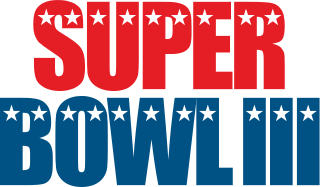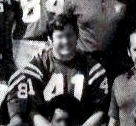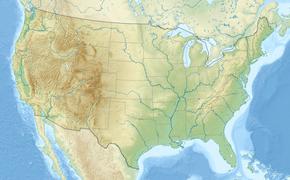
John Constantine Unitas was an American football quarterback who played 18 seasons in the National Football League (NFL), primarily with the Baltimore Colts. Following a career that spanned from 1956 to 1973, he has been listed as one of the greatest NFL players of all time.

Super Bowl III was an American football game played on January 12, 1969, at the Orange Bowl in Miami, Florida. It was the third AFL–NFL Championship Game in professional American football, and the first to officially bear the trademark name "Super Bowl". Super Bowl III is regarded as one of the greatest upsets in both American football history and in the history of professional sports. The 19 1⁄2- points underdog American Football League (AFL) champion New York Jets defeated the National Football League (NFL) champion Baltimore Colts by a score of 16–7.
Super Bowl V was an American football game played between the American Football Conference (AFC) champion Baltimore Colts and the National Football Conference (NFC) champion Dallas Cowboys to determine the National Football League (NFL) champion for the 1970 season. It was the fifth edition of the Super Bowl and the first modern-era NFL championship game. The Colts defeated the Cowboys by the score of 16–13 on a field goal with 5 seconds left in the game. The game was played on January 17, 1971, at the Orange Bowl in Miami, Florida, and was the first Super Bowl game played on artificial turf; specifically, the game was played on a Poly-Turf surface.

The National Football League playoffs for the 1971 season began on December 25, 1971. The postseason tournament concluded with the Dallas Cowboys defeating the Miami Dolphins in Super Bowl VI, 24–3, on January 16, 1972, at Tulane Stadium in New Orleans, Louisiana.
The NFL playoffs following the 1969 NFL season determined the league's representative in Super Bowl IV.
The NFL playoffs following the 1968 NFL season determined who would represent the league in Super Bowl III.

Thomas Roland Matte(Pronounced: MAT-tee) was an American professional football player who was a running back in the National Football League (NFL) in the 1960s and 1970s and earned a Super Bowl ring. He attended Shaw High School in East Cleveland and was an Eagle Scout. Matte was an All-American quarterback playing college football at Ohio State University.
The 1958 NFL Championship Game was the 26th NFL championship game, played on December 28 at Yankee Stadium in New York City. It was the first NFL playoff game to be decided in sudden death overtime. The Baltimore Colts defeated the New York Giants 23–17 in what soon became widely known as "the Greatest Game Ever Played". Its legendary status in the pantheon of historic NFL games was again confirmed by a nationwide poll of 66 media members in 2019, who voted it the best game in the league's first 100 years.

Earl Edwin Morrall was an American professional football player who was a quarterback in the National Football League (NFL) for 21 seasons, both a starter and reserve. He started for six teams, most notably with the Baltimore Colts and the Miami Dolphins. He became known as one of the greatest backup quarterbacks in NFL history, having served in the capacity for two Hall of Fame quarterbacks in Johnny Unitas and Bob Griese. An injury to Unitas in 1968 saw Morrall step in to start the season that saw the Colts to a 13–1 record that saw them win their first NFL Championship in nine years before ineffective play in Super Bowl III saw him benched for Unitas. Two years later, in Super Bowl V, Morrall came off the bench for an injured Unitas and kept the Colts in the game before they ultimately won on a last-second field goal. In his first season with Miami in 1972, he came off the bench when Griese became injured early in the year, with Morrall winning all nine starts; Morrall started the first two playoff games, with Griese playing in each game before being named the starter for Super Bowl VII, where the Dolphins completed the only perfect season in NFL history.

The 1964 NFL Championship Game was the 32nd annual championship game, held on December 27 at Cleveland Stadium in Cleveland, Ohio. With an attendance of 79,544, it was the first NFL title game to be televised by CBS.
The 1968 Cleveland Browns season was the team's 19th season with the National Football League. The Browns made it to the playoffs for the 2nd straight year thanks to an 8-game winning streak. Quarterback Bill Nelsen replaced Frank Ryan as the starting quarterback prior to week 4 of their season.

The 1972 Miami Dolphins season was the franchise's seventh season and third in the National Football League (NFL). The team was led by third-year head coach Don Shula and achieved the only perfect season in NFL history. They also led the league in both points scored and fewest points allowed.
The 1969 Pittsburgh Steelers season was the franchise's 37th in the National Football League. It would mark a turning point of the Steelers franchise. 1969 was the first season for Hall of Fame head coach Chuck Noll, the first season for defensive lineman "Mean Joe" Greene and L. C. Greenwood, the first season for longtime Steelers public relations director Joe Gordon, and the team's last season in Pitt Stadium before moving into then-state-of-the-art Three Rivers Stadium the following season.
The 1971 Pittsburgh Steelers season was the team's 39th in the National Football League. The Steelers showed improvement finishing in second place in the AFC Central Division with a 6–8 record. Terry Bradshaw struggled with turnovers in his second season throwing 22 interceptions to 13 touchdown passes. The Steelers that year drafted wide receiver Frank Lewis, Hall of Fame linebacker Jack Ham, guard Gerry Mullins, defensive end Dwight White, tight end/tackle Larry Brown, defensive tackle Ernie Holmes, and safety Mike Wagner, all key contributors during the Steelers Super Bowl teams of the 1970s.
The 1968 Pittsburgh Steelers season was the team's 36th in the National Football League.
The 1968 Baltimore Colts season was the 16th season for the team in the National Football League (NFL). Led by sixth-year head coach Don Shula, they finished the regular season with a record of 13 wins and 1 loss, and won the Western Conference's Coastal division.

The 2011 Indianapolis Colts season was the franchise's 59th season in the National Football League (NFL), the 28th in Indianapolis and the third under head coach Jim Caldwell. The Colts were coming off a 10–6 record in 2010 and a second consecutive AFC South championship, as well as a ninth consecutive playoff appearance.
The 1970 AFC Championship Game was the inaugural title game of the American Football Conference (AFC). Played on January 3, 1971, the game was hosted by the AFC East champion Baltimore Colts who played the AFC West champion Oakland Raiders at Memorial Stadium in Baltimore, Maryland. Along with the 1970 NFC Championship Game played on the same day, this game constituted the penultimate round of the 1970–71 NFL playoffs which had followed the 1970 regular season of the National Football League.
The Miracle at the Met refers to the Minnesota Vikings' comeback win over the Cleveland Browns in Week 15 of the 1980 NFL season. The Vikings trailed 23–9 in the fourth quarter, but won after Vikings quarterback Tommy Kramer passed for two touchdowns to wide receiver Ahmad Rashad in the last two minutes, including a 46-yard Hail Mary pass caught with one hand on the last play of the game. The final play is also known as the "Miracle Catch." The Vikings won, 28–23.

The 2020 season was the Cleveland Browns' 68th as a member of the National Football League (NFL), their 72nd overall, and their first under general manager Andrew Berry and head coach Kevin Stefanski. The Browns improved on their 6–10 record from 2019 and finished 11–5, clinching their first winning season since 2007 and their best since 1994. They also ended their franchise-record and league-high 18-year playoff drought, making it to the playoffs for the first time since 2002.









